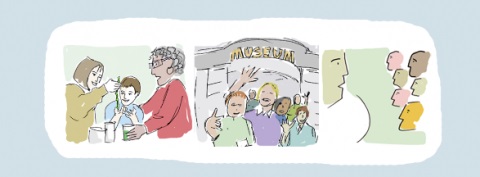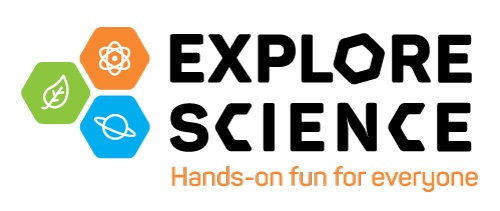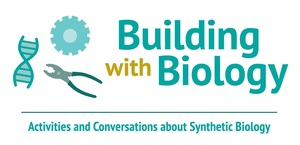Welcome to the June e-newsletter for the National Informal STEM Education (NISE) Network and community.
INSIDE THIS ISSUE
INSIDE THIS ISSUE
- Community News - NISE Network partner honored with 2016 Nancy Hanks Award, Building with Biology news and updates, "NanoDays Collection" printed book shipping soon to active NISE Network partners, Recap from the Association of Children's Museums (ACM) Interactivity 2016, National Informal STEM Education (NISE) Network transition
- Upcoming Events - Upcoming online workshops: Staying connected to the Network and community
- Featured on the Website - Sharing Science Workshop & Practicum gets researchers quickly up to speed with family audiences; "NanoDays Collection" digital download now online; DIY Nano Book; NanoDays: A NISE Network Guide to Creating Activity Kits, Building Communities, and Inspiring Learning; Program Development: A NISE Network Guide to Creating Effective Learning Experiences for Public Audiences; Final gathering of the Center for Nanotechnology in Society (CNS)
- Partner Highlight - Center for Nanotechnology in Society, Arizona State University
- Science in the News - Nanoparticles in baby formula: should parents be worried?, Biological programming, NASA's Kepler mission announces largest collection of planets ever discovered, SpaceX makes fourth successful rocket landing
- Nano Throughout the Year - World Oceans Day (June 8), Sun and Sand, Summer Camp
COMMUNITY NEWS

→ Recap from the Association of Children's Museums (ACM) Interactivity 2016
 Thank you to partners who stopped by the NISE Network booth and who attended the Network sessions around museums and community partnerships. The presentations and resources from these sessions are now online and available to download.
Thank you to partners who stopped by the NISE Network booth and who attended the Network sessions around museums and community partnerships. The presentations and resources from these sessions are now online and available to download.
→ National Informal STEM Education (NISE) Network transition
Congratulations to NISE Network partner, Jayatri Das, Ph.D., Chief Bioscientist at The Franklin Institute in Philadelphia, who received the 2016 Nancy Hanks Memorial Award for Professional Excellence at this year's American Alliance of Museums (AAM) Annual Meeting. This award honors a museum professional with less than ten years experience in the museum field and recognizes a specific achievement that has benefited either the honoree's home institution or the museum field in general. Praised by The Franklin Institute's Senior VP of Science & Education, Frederic Bertley shares that Jayatri "inspires a passion for anybody to learn around science and technology." Watch a short video by AAM that highlight's the 2016 Nancy Hanks Award Winner, Jayatri Das.
→ Building with Biology news and updates

We're please to share that over 160 Building with Biology physical kits have been awarded to science centers, museums, research institutions, DIY bio labs, and iGEM teams across the U.S. to host Summer 2016 Building with Biology events and forums [see list of recipients]. Even more exciting news is that the physical kits have shipped and will be arriving soon [see blog post]!
New Building with Biology materials have been updated on the website!
All new materials and resources for the hands-on activities and forums have been updated online.
- Kit Contents - Learn more about the individual hands-on activities included in the kit.
- Forums - The newest forum, Should We Edit the Genome? When, Why, and How Much?, and its resources is now available.
- Digital Kit Contents - Digital versions of all the educational and professional materials provided in the physical kit are online and free to download.
- Training Videos - Training videos for the hands-on activities are now available online.
- What's in your Building with Biology Kit webinar - Join us for the June 21st webinar that will provide an overview of all the educational and professional development resources provided in your kit, and get your questions answered!
"NanoDays Collection" printed book shipping soon to active NISE Network partners
 The NISE Network will soon be shipping a box of printed and digital materials to selected NISE Network partner museums and universities located in the US. The NISE Network leadership wants to thank partner organizations for your involvement with the Nanoscale Informal Science Education Network (NISE Net) and for all your efforts to engage public audiences in nanoscale science, engineering and technology over the past years. We are pleased to share a compendium of all the NanoDays activities developed over the past ten years. For most partner organizations, we are only mailing one box so please share these resources with your colleagues and local collaborators.
The NISE Network will soon be shipping a box of printed and digital materials to selected NISE Network partner museums and universities located in the US. The NISE Network leadership wants to thank partner organizations for your involvement with the Nanoscale Informal Science Education Network (NISE Net) and for all your efforts to engage public audiences in nanoscale science, engineering and technology over the past years. We are pleased to share a compendium of all the NanoDays activities developed over the past ten years. For most partner organizations, we are only mailing one box so please share these resources with your colleagues and local collaborators.
→ Recap from the Association of Children's Museums (ACM) Interactivity 2016
 Thank you to partners who stopped by the NISE Network booth and who attended the Network sessions around museums and community partnerships. The presentations and resources from these sessions are now online and available to download.
Thank you to partners who stopped by the NISE Network booth and who attended the Network sessions around museums and community partnerships. The presentations and resources from these sessions are now online and available to download. → National Informal STEM Education (NISE) Network transition
UPCOMING EVENTS
FEATURED ON THE WEBSITE
→ Sharing Science Workshop & Practicum gets researchers quickly up to speed with family audiences


 In this blog post, Larry Bell, NISE Network Director, recently attended the Center for Nanotechnology in Society's final event that commemorated ten year's of work around anticipatory governance, of which one of the key components is "engagement." Bell states that the collaboration between NISE Net and CNS was transformative for both organizations.
In this blog post, Larry Bell, NISE Network Director, recently attended the Center for Nanotechnology in Society's final event that commemorated ten year's of work around anticipatory governance, of which one of the key components is "engagement." Bell states that the collaboration between NISE Net and CNS was transformative for both organizations.
PARTNER HIGHLIGHT
→ Center for Nanotechnology in Society, Arizona State University
→ Upcoming online workshops: Staying connected to the Network and community
There is no charge to participate in any of the online workshops.


The Building with Biology project is hosting online workshops and project orientations throughout June and July to provide support to host sites in preparation for summer events and forums.
The American Association for the Advancement of Science (AAAS) will be hosting a series of upcoming online project orientations for Building with Biology scientist volunteers.
*Note that the dates of these webinars have been changed. For more information, visit http://www.buildingwithbiology.org/orientation.
- Building with Biology: Public Engagement Fundamentals (for scientists)
- Building with Biology: All about Audiences (for scientists)
- Building with Biology: Communicating Synthetic Biology (for scientists)
Other Building with Biology online workshops include
- 6/14: Evaluating the Public's Experience at Building with Biology Events (for host site staff)
- 6/21: What's in your Building with Biology Kit (for host site staff)
- 6/23: Evaluating Building with Biology Forums (for host site staff)
In case you missed it
A recording of the following webinars and their resources are available here.
- 5/16: Host Site Overview - Communicating Synthetic Biology
- 4/28: Engaging Audiences in Science through Building with Biology Public Forums
FEATURED ON THE WEBSITE
→ Sharing Science Workshop & Practicum gets researchers quickly up to speed with family audiences

Seeing a child’s face light up with excitement as they interact with real-life scientists at your outreach event is always a pleasure. Many researchers are interested in sharing their knowledge and enthusiasm with the public, but they typically need some prior guidance and practice working hands-on with public audiences. With this in the mind, the NISE Network created the Sharing Science Workshop & Practicum (SSW&P), a time-efficient, low-cost, low-commitment solution to preparing researchers for successful interactions with youth and community audiences. Last fall, the NISE Net also offered a limited number of Implementation Grants to help institutions adopt and host the SSW&P in advance of their NanoDays or other outreach events. Six NISE Net partners signed on for this opportunity, and together, they prepared 116 researchers to light up those visitor faces with the joy of discovery.
As the Nanoscale Informal Science Education Network ends, the
NISE Net has created this compendium of all NanoDays activities and resources to enhances partners' ability to continue to host NanoDays events and strengthen local partnerships. We've selected dates to promote national participation in NanoDays in the years to come, however, these materials can be adapted for use anytime of the year in various other events and regular programs.
The Nanoscale Informal Science Education Network's full collection of do-it-yourself science activities that investigate the nanoscale - the scale of atoms and molecules! These 'Do It Yourself' Nano activities and experiments allow families to experience and learn about nanoscale science, engineering, and technology at home or on the go!
The guide describes the planning and development of NanoDays resources by a cross-organizational team, fabrication and distribution of the physical kits, implementation by hundreds of partners across the country through annual NanoDays events, and the impact of the initiative on public audiences.
This guide offers a comprehensive overview of NISE Network programming, including development by a multi-organization team, implementation by hundreds of partners nationwide, and impact on public audiences. It offers a practical introduction to the approaches, methods, and tools the Network uses to ensure our programs provide effective learning opportunities.
 In this blog post, Larry Bell, NISE Network Director, recently attended the Center for Nanotechnology in Society's final event that commemorated ten year's of work around anticipatory governance, of which one of the key components is "engagement." Bell states that the collaboration between NISE Net and CNS was transformative for both organizations.
In this blog post, Larry Bell, NISE Network Director, recently attended the Center for Nanotechnology in Society's final event that commemorated ten year's of work around anticipatory governance, of which one of the key components is "engagement." Bell states that the collaboration between NISE Net and CNS was transformative for both organizations. PARTNER HIGHLIGHT
→ Center for Nanotechnology in Society, Arizona State University
By Deron Ash, Arizona State University
In 2005, the National Science Foundation simultaneously announced funding both for NISE Net and the Center for Nanotechnology in Society at Arizona State University (CNS-ASU). Up to that point, the two proposed projects weren’t aware of each other, but after a few email exchanges and phone calls, Principal Investigators Larry Bell (NISE Net) and David Guston (CNS-ASU) initiated what would turn into many years of productive work together. CNS-ASU ideas have been incorporated into many NISE Net educational products, and so are integral to the public engagement work of many NISE Net partners.
CNS-ASU recently commemorated the ending of its NSF grant funding by bringing together over 100 faculty members, researchers, students and staff who have played a key role in the successful eleven year history of the Center. Participants representing nearly 50 institutions from 10 countries traveled to take part in the conference and festivities, including Larry Bell from the Museum of Science. Entitled "Advancing the Legacy of Anticipatory Governance," the event was designed both as a reflective retrospective of the impacts and outcomes of CNS-ASU as well as an exploration of the ways participants can, and already are, carrying on the legacy of the Center.
Continue to the full Partner Highlight to learn about the impacts this collaboration has had on CNS-ASU and the NISE Network.
SCIENCE IN THE NEWS
NANO THROUGHOUT THE YEAR
Do you have something you would like to submit for inclusion in the NISE Network monthly e-newsletter? Please send your announcements, articles, or community opportunities to Kayla Berry at [email protected].
→ Nano News
A team of scientists from Arizona State University recently analyzed six commonly available off-the-shelf baby formulas (liquid and powder) and found nanometer-scale particles made up of hydroxyapatite in three of the formulas. Hydroxyapatite is a calcium-rich mineral and is naturally made in our bodies as an essential part of bones and teeth, however, under super high magnification these nanoparticles resemble sharp needle-like structures that may behave and react differently in the body at the nanoscale. In non-nano form, hydroxyapatite is classified by the US Food and Drug Administration (FDA) as "Generally Regarded as Safe," however the agency has raised concerns that nanoscale versions of food ingredients may not be as safe as their larger counterparts, or at least requires reevaluation before being added to food products.
→ Synthetic Biology News
A new tool makes programming living cells like writing computer software. Although scientists have been programming biological circuits for several years now, researchers from MIT have recently developed a tool that makes it possible to design DNA circuits for living cells. The new tool, called "Cello," enables users to automate the design of cellular circuits by simply inputting a design and the program will convert it into a DNA sequence that executes a specific function, like producing a drug.
→ Space and Earth News
Based on analysis performed on the Kepler space telescope's July 2015 planet catalog, which identified over 4,000 potential planets, 1,284 of the candidates were verified as new planets, which is is the single largest finding of planets to date. Before the Kepler space telescope launched in 2009, scientists didn't know whether exoplanets were rare or common in the galaxy but with Kepler, scientists now know there could be more planets than stars. Kepler is helping to provide a deeper understanding of the number of stars that harbor potentially habitable, Earth-size planets, a number that's needed to design future missions to search for habitable environments and living worlds.
Launched in 2002, SpaceX was founded to revolutionize launch and space technology by making rocket components reusable, with the ultimate goal of enabling people to live on other planets. SpaceX designs, manufactures and launches advanced rockets and spacecraft, including the Falcon 9 rocket. SpaceX has managed to successfully launch rockets into geostationary transfer orbit, further than the low-Earth orbit of the International Space Station, and land the rockets both on land and on ocean platforms.
NANO THROUGHOUT THE YEAR

Enjoy the variety of summer-related activities but don't forget about NISE Net's other programs and activities relating to superheroes, food, and astronomy and space!

Enjoy the variety of summer-related activities but don't forget about NISE Net's other programs and activities relating to superheroes, food, and astronomy and space!
World Oceans Day (June 8)
- worldoceansday.org
- Cleaning Our Water with Nanotechnology program
- The Water Race: Hydrophobic and Hydrophilic Surfaces hands-on activity
- Why are Seashells so Strong? hands-on activity
- What’s Nano About Water? video
- DragonflyTV - Water Clean Up video
- Oil Spill Clean Up Simulation hands-on activity
Sun and Sand
- Nano Ice Cream program
- Invisible Sunblock hands-on activity
- Magic Sand / Nanosurfaces hands-on activity
- Exploring Products - Sunblock hands-on activity
- Ready, Set, Self-Assemble is a fun, outdoor group program
- Why are Seashells so Strong? hands-on activity
Summer Camp
- Nanotechnology Summer Camp (Ages 8 - 10) framework
- High School Nanotechnology Summer Camp framework
For a list of of nano activities for use throughout the year, see NISE Net's list of seasonal activities.
MEETINGS AND CONFERENCES
June 13 - 14 - International Public Science Events Conference - Boston, MA
July 19 - 23 - Visitor Studies Association (VSA) - Boston, MA
September 24 - 27 - Association of Science Technology Centers (ASTC) Annual Conference 2016 - Tampa, FL - Registration now open
Do you have something you would like to submit for inclusion in the NISE Network monthly e-newsletter? Please send your announcements, articles, or community opportunities to Kayla Berry at [email protected].



